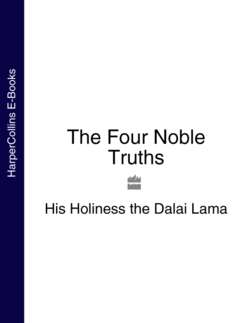Читать книгу The Four Noble Truths - Далай-лама XIV, Литагент HarperCollins USD, Дуглас Абрамс Арава - Страница 7
Taking Refuge and Generating Bodhichitta
ОглавлениеFirst, I will introduce these principles in traditional Buddhist terms. Technically, we become a Buddhist when we decide to take Refuge in the Three Jewels, and when we generate bodhichitta, which is known as compassion, the altruistic mind, or our good heart. The Three Jewels of Buddhism are the Buddha; the Dharma, his teaching; and the Sangha or community of practitioners. It is very clear that the idea of helping others lies at the heart of both Refuge and Bodhichitta. The practice of Generating Bodhichitta explicitly entails committing oneself to activities which are primarily aimed at helping others; while the practice of Taking Refuge lays the foundation for the practitioner to lead his or her life in an ethically disciplined way, avoiding actions that are harmful to others and respecting the laws of karma.
Unless we have a good foundational experience of the practice of Taking Refuge in the Three Jewels, we will not be able to have a high level of realization of bodhichitta. It is for this reason that the distinction between a practising Buddhist and a non-Buddhist is made on the basis of whether or not an individual has taken Refuge in the Three Jewels.
However, when we talk about Taking Refuge in the Three Jewels, we should not imagine that it simply involves a ceremony in which we formally take Refuge from a master, or that merely by virtue of participating in such a ceremony we have become a Buddhist. There is a formal Refuge ceremony in Buddhism, but the ceremony is not the point. The point is that as a result of your own reflection, even without a master, you become fully convinced of the validity of the Buddha, Dharma and Sangha as the true ultimate objects of refuge, and that is when you actually become a Buddhist. You entrust your spiritual wellbeing to the Three Jewels, and this is what is really meant by Taking Refuge. On the other hand, if there is any doubt or apprehension in your mind about the validity of Buddha, Dharma and Sangha as being the ultimate objects of refuge, even though you may have taken part in a Refuge ceremony, that very suspicion or doubt prevents you from being a practising Buddhist, at least for the time being. It is therefore important to understand what these objects of refuge are.
When we speak about Buddha in this context, we should not confine our understanding of the word to the historical person who came to India and taught a certain spiritual way of life. Rather, our understanding of buddhahood4 should be based on levels of consciousness, or levels of spiritual realization. We should understand that buddhahood is a spiritual state of being. This is why the Buddhist scriptures can speak about past buddhas, buddhas of the present and buddhas of the future.
Now the next question is: how does a buddha come into being? How does a person become fully enlightened? When we reflect on buddhahood, we are bound to ask ourselves whether or not it is possible for an individual to attain such a state, to become a fully enlightened being, a buddha. Here we find that the key lies in understanding the nature of Dharma. If the Dharma exists, then the Sangha will certainly exist – the Sangha are those who have engaged in the path of the Dharma, and who have realized and actualized its truth. If there are Sangha members who have reached spiritual states where they have overcome at least the gross levels of negativity and afflictive emotions, then we can envision the possibility of attaining a freedom from negativity and afflictive emotions which is total. That state is what we call buddhahood.
In the present context, I think we must make a distinction between the use of ‘Dharma’ as a generic term and its use in the specific framework of the Refuge. Generically, it refers to the scriptural Dharma – the Buddha’s teaching and the spiritual realizations based on the practice of that teaching. In relation to the Refuge it has two aspects: one is the path that leads to the cessation of suffering and afflictive emotions, and the other is cessation5 itself. It is only by understanding true cessation and the path leading to cessation that we can have some idea of what the state of liberation is.
